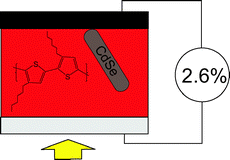Improved efficiency of photovoltaics based on CdSe nanorods and poly(3-hexylthiophene) nanofibers
Abstract
We present photovoltaic devices based on a blend of the

* Corresponding authors
a
Cavendish Laboratory, Madingley Road, Cambridge, UK
E-mail:
ncg11@cam.ac.uk
Fax: +44 1223 764515
Tel: +44 1223 766301
We present photovoltaic devices based on a blend of the

 Please wait while we load your content...
Something went wrong. Try again?
Please wait while we load your content...
Something went wrong. Try again?
B. Sun and N. C. Greenham, Phys. Chem. Chem. Phys., 2006, 8, 3557 DOI: 10.1039/B604734N
To request permission to reproduce material from this article, please go to the Copyright Clearance Center request page.
If you are an author contributing to an RSC publication, you do not need to request permission provided correct acknowledgement is given.
If you are the author of this article, you do not need to request permission to reproduce figures and diagrams provided correct acknowledgement is given. If you want to reproduce the whole article in a third-party publication (excluding your thesis/dissertation for which permission is not required) please go to the Copyright Clearance Center request page.
Read more about how to correctly acknowledge RSC content.
 Fetching data from CrossRef.
Fetching data from CrossRef.
This may take some time to load.
Loading related content
